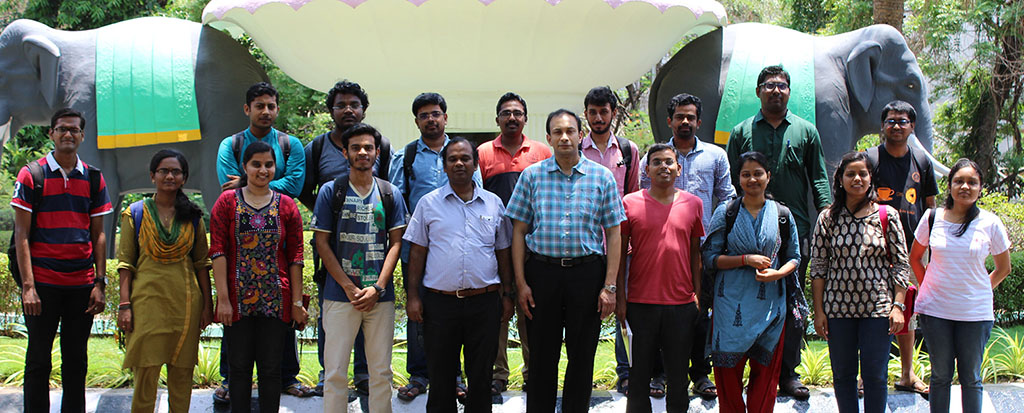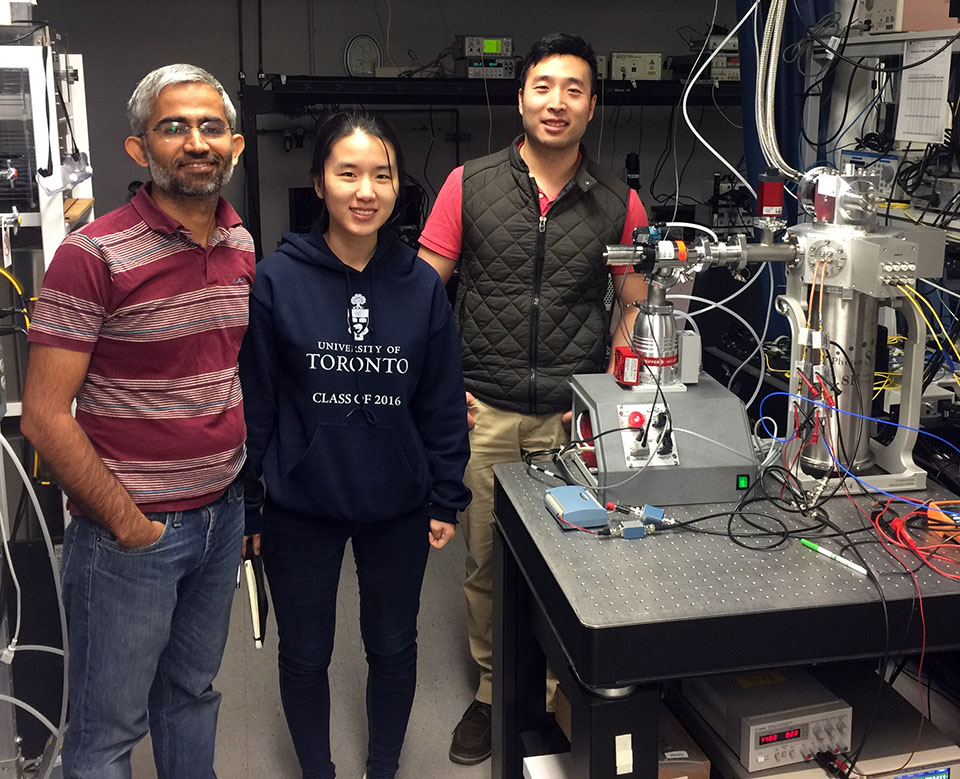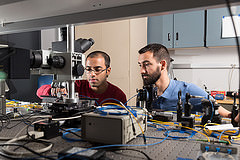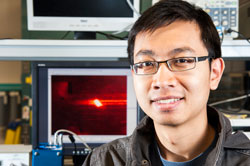PhD Thesis Award
San Diego, Calif., June 7, 2023 - PhD student Xiaoxi Wang wins the ECE Department W. S. C. Chang Ph.D. Thesis Award, for his thesis titled "Expanding Silicon Photonics through Novel Components and Applications". Congratulations, Josh.
Best paper award
Basel, Switzerland, Feb 20, 2023 - Our joint paper with Prof. Lukas Eng and his team (''Seeing Is Believing'' - In-Depth Analysis by Co-Imaging of Periodically-Poled X-Cut Lithium Niobate Thin Films") is the winner of Crystals 2021 Best Paper Award.
The winner receives CHF 500 and an opportunity to publish in the journal free of charge. Congratulations to the team!
Recent highlighted papers
San Diego, Calif., June 24, 2020 - Three of our recent journal papers have been highlighted as OSA Spotlight in Optics, AIP SciLight and JAP Editor's Pick.
Congratulations to the PhD students Chaoxuan Ma, Jie Zhao and post-doctoral researcher Michael Rüsing, and thank you to the community for the recognition.
PhD Thesis Award
San Diego, Calif., May 21, 2018 - PhD student Peter Weigel wins the ECE Department Thesis Award, for his thesis titled "High-Speed Hybrid Silicon-Lithium Niobate Electro-Optic Modulators & Related Technologies". Congratulations, Peter.
IBM PhD Fellowship
San Diego, Calif., April 3, 2018 - PhD student Chaoxuan Ma selected for a prestigious IBM PhD Fellowship. The IBM PhD Fellowship Awards Program [URL], created in the 1950s, is an intensely competitive worldwide program, which honors exceptional PhD students who have an interest in solving problems that are important to IBM and fundamental to innovation in many academic disciplines.
Chaoxuan's graduate research is on quantum information and communication technologies based on photonics. Her research has been published in first-author papers in Optics Express, Optica and IoP Quantum Science and Technology, and in multiple presentations at the CLEO Conference, including a post-deadline paper last year in collaboration with Intel. Congratulations, Ellen.
NASA Graduate Fellowship
San Diego, Calif., Apr 28, 2017 - PhD student Xiaoxi Wang selected for a prestigious NASA Space Technology Research Fellowship, renewable up to 4 years, for his proposed research and training on Integrated Photonics for Space Communications. Congratulations, Josh.
Josh, who received his B.S. in EECS from MIT, joins a select group of students from our research group who have won multi-year external fellowships: Jung Park (NSF Graduate Fellowship), Jun Ron Ong (AStar Fellowship) and Peter Weigel (NDSEG).
Equipment installation
San Diego, Calif., Apr 15, 2017 - Our lab gets a significant boost in single-photon measurement capabilities with the installation of our new superconducting detector system built up by Photon Spot Inc.(Vikas Anant) [URL].
We are grateful to Matt Shaw for providing SNSPD WSi detectors made by JPL (NASA) for our NSF ACQUIRE project measurements on quantum optical communications.
Poster prize at OFC OIDA Workshop 2017
PhD student Peter O. Weigel wins second prize at the OIDA 2017 Conference and Poster Competition at OFC 2017, showcasing student research from within the CIAN ERC. Congratulations, Peter.
Peter's research in hybrid Si-Lithium Niobate devices may result in a new hybrid device technology for linear and nonlinear devices which can be made using silicon photonics multi-project wafer processes. His research is supported by grants from NSF and an NDSEG fellowship.
Training and outreach short-course, IIT Madras
Chennai, India, March, 2017 - Prof. Mookherjea and Prof. Bijoy Das (IIT Madras) taught a short-course (2 weeks) on Silicon Photonics at IIT Madras. Post-graduate and undergraduate students from IIT Madras and several other institutions attended this GIAN (Global Initiative of Academic Networks) course.
Many thanks to the excellent hospitality of the IIT Madras faculty, students and staff, and especially Prof. Das, for making this possible.

Tunable photon-pair spectrum using a silicon nanophotonics chip.
San Diego, Calif., Dec 15, 2014 - A team of researchers from the University of California San Diego have demonstrated a way to emit and control quantum light using a chip made from silicon - one of the most widely used materials used in modern electronics.
The UC San Diego researchers recently described their new device's performance online in the journal Nature Communications, available via Open Access [URL].
Ryan Aguinaldo to represent UC San Diego at the 2014 Catalyzing Advocacy in Science and Engineering Workshop.
San Diego, Calif., Mar 10, 2014 - Ryan Aguinaldo has been selected as one of two graduate students to represent UC San Diego at CASE 2014: Catalyzing Advocacy in Science and Engineering, a three-day workshop developed by AAAS in Washington, DC. He will interact with members of the United States Congress and their staff to learn about the federal budget process, policy making, and effective science advocacy and communication at the national level.
Ryan is a senior graduate student in the Micro/Nano-Photonics Group led by Professor Shayan Mookherjea. His research on silicon photonic devices for optical networks is valuable to the Center for Integrated Access Networks, an NSF Engineering Research Center. Ryan has been President of the ECE Graduate Student Council and an officer of the student chapters of IEEE, OSA, and SPIE. The United Nations has been declared 2015 as the "International Year of Light" and Ryan will be contributing to raising awareness of optics and photonics research on Capitol Hill.
UC San Diego leads international team of researchers to demonstrate first heralded single-photon generation from a silicon chip
San Diego, Calif., April 30, 2012 - An international consortium of researchers has overcome an important barrier to the generation of single photons using a tiny, chip-scale device constructed from the most widely used material underpinning modern electronics: silicon.
Their findings could hasten the advent of devices for quantum communication, ultra-low-power computing and other technologies now that all three basic components (sources, controllable circuits and detectors) of a quantum transceiver have been demonstrated using silicon photonics.
The researchers announced today that, for the first time, they generated so-called heralded single photons from a silicon chip. Heralded photons are the second in a pair of spontaneously-generated photons: when the first hits a detector and provides timing information, it 'heralds' the companion photon, which is then in a quantum mechanical single photon state.
To get heralded single photons, the group built upon a technique previously demonstrated in silicon called photon pair generation, on which many important theoretical and experimental advances have been made by groups at Northwestern, Cornell, NTT Laboratories in Japan, the University Libre de Bruxelles in Belgium, the University of Briston in the UK, and the University of Sydney in Australia.
Led by the University of California, San Diego, other collaborators on the project include the National Institute of Standards and Technology (NIST) in Gaithersburg, Maryland and the Politecnico di Milano (Milan, Italy).

The 0.5 mm x 0.05 mm-sized device reported in this research was fabricated using CMOS-compatible processes on 200 mm silicon-on-insulator (SOI) wafers at an external collaborative research foundry, and operates at room temperature, generating quantum light in the near-1550 nanometer wavelength.
"That is in the infrared range and it is technologically important because those wavelengths are used in today's optical fiber networks," said Shayan Mookherjea, an associate professor of electrical and computer engineering at UC San Diego's Jacobs School of Engineering. "Chip-scale single-photon sources could be used in quantum devices, networks and systems to bring about enormous improvements over their classical counterparts in terms of speed or security or computational complexity."
Results of the research will be presented in an invited talk by UC San Diego graduate student Junrong Ong at the Conference on Lasers and Electro-Optics (CLEO) on Thursday, May 10, 2012 at 3:30 pm (Session CTh3M).
Mr. Ong is a third-year graduate student in Mookherjea's Micro/Nano-Photonics group (http://mnp.ucsd.edu). This paper was selected as one of three finalists in the prestigious Maiman Student Paper Competition, which recognizes student innovation, research excellence and presentation skills in the areas of laser technology and electro-optics. The best-paper competition is endowed by HRL Laboratories, LLC, IEEE Photonics Society and APS Division of Laser Science.



